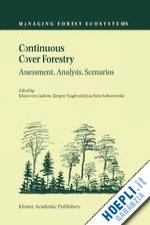Resource Assessment and Monitoring. Stand Canopy Closure Estimated by Line Sampling with airborne Lidar; S. Magnussen, et al. Resource assessment techniques for Continuous Cover Forest systems; M. Köhl. Continuous cover forestry - new challenges for remote sensing; T. Zawila-Niedzwiecki, E. Wisniewska. An efficient approach to combine remote sensing and sample-based inventory for forest enterprises changing to near-natural forest management; M. Dees, et al. Monitoring of Forests under Continuous Cover System Management 'Tools for the Regionalisation of Forest Inventories'; J. Nieschulze, J. Saborowski. Analysis of Genetic Structure. Reproduction in continuous cover forests - the geneticist's perspective; R. Finkeldey. Effects of different silvicultural treatments on the genetic structure of European beech populations (Fagus sylvatica L.); K. Dounavi, et al. Target-diameter felling and consequences for gentic structures in a beech stand (Fagus sylvatica L.); M. Ziehe, H.H. Hattemer. Analysis of Forest Structure. Calibrating predicted diameter distribution with additional information for structurally diverse forest stands; J. Puumalainen, et al. Forest structure and diameter growth in maritime pine in a Mediterranean area; F. Bravo, B. Guerra. Analysis of mapped point patterns by nearest-neighbor indices - on the nearest-neighbor reciprocity and edge-effect corrections; E. Pinto Preuhsler. Spatial, Age and Diameter Structure of the Semi-natural Scots Pine Stands on Coastal Dunes in Latvia; J. Donis. Scenarios and control. Stem number guide curves for uneven-aged forsts - development and limitations; J. Cancino, K. von Gadow. A growth model and harvest allocation algorithm for timber and non-timber productmanagement planning in Iwokrama Forest, Guyana; D. Alder, et al. Generating management alternatives for multi-species stands using the decision-support system BWINPRO; M. Albert. Using logistic regression to model tree selection preferences for harvesting in forests in conversion; T. Ledermann. A methodology for the retrospective analysis of the releasement response of old aged European beech trees; A. Haywood, H. Spiecker. Preliminary study for a flexible growth model to predict the consequences of CCF in Wales; A. Pommerening, G. Wenk. Tree diversity, landscape diversity, and economics of maple-birch forests: Implications of Markovian models; C.-R. Lin, J. Buongiorno. Economic Evaluation of Uneven-aged Management; L. Valsta. Regional Experiences. Continuous cover forestry in the United States &endash; experience with Southern Pines; J.M. Guldin. Continuous cover forestry systems in tropical and subtropical forests &endash; current state and future perspectives; A.H.W. Seydack. The place of Continuous Forestry among the Silvicultural Systems in Poland; W. Gil, et al. Index.











